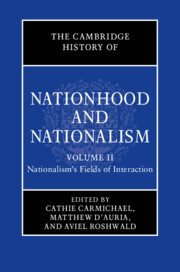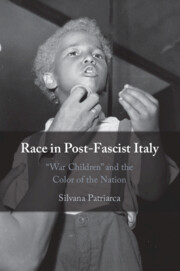Refine search
Actions for selected content:
50 results
Chapter 7 - Tragedy
- from Part I - Forms and Genres
-
-
- Book:
- The Cambridge Companion to Modernist Theatre
- Published online:
- 28 August 2025
- Print publication:
- 11 September 2025, pp 126-143
-
- Chapter
- Export citation
Chapter 13 - Race
- from Part II - Themes and Issues
-
-
- Book:
- The Cambridge Companion to Modernist Theatre
- Published online:
- 28 August 2025
- Print publication:
- 11 September 2025, pp 233-249
-
- Chapter
- Export citation
Shona Oral Traditions and the Quest for Cognitive Justice: What Shona Public Humanities Contribute to a World in Crisis
- Part of
-
- Journal:
- Public Humanities / Volume 1 / 2025
- Published online by Cambridge University Press:
- 04 September 2025, e135
-
- Article
-
- You have access
- Open access
- HTML
- Export citation
9 - Joyce, Colonialism, and Nationalism
-
-
- Book:
- The Cambridge Companion to James Joyce
- Published online:
- 14 August 2025
- Print publication:
- 21 August 2025, pp 153-168
-
- Chapter
- Export citation
Archaeology, Eurocentrism, and the British Historical Worldview
-
- Journal:
- European Journal of Archaeology , First View
- Published online by Cambridge University Press:
- 20 August 2025, pp. 1-20
-
- Article
-
- You have access
- Open access
- HTML
- Export citation
Whose age of anxiety? Provincialising ontological insecurity
-
- Journal:
- Review of International Studies , First View
- Published online by Cambridge University Press:
- 22 July 2025, pp. 1-20
-
- Article
-
- You have access
- Open access
- HTML
- Export citation
Late Antiquity, post-modernity, and Islam: the 1970s as a point of departure and retrospection
-
- Journal:
- Byzantine and Modern Greek Studies / Volume 49 / Issue 1 / April 2025
- Published online by Cambridge University Press:
- 27 March 2025, pp. 22-28
- Print publication:
- April 2025
-
- Article
-
- You have access
- Open access
- HTML
- Export citation
18 - Post-Colonialism and Sexuality
-
-
- Book:
- The Cambridge World History of Sexualities
- Published online:
- 26 April 2024
- Print publication:
- 16 May 2024, pp 388-410
-
- Chapter
- Export citation
Global sociology and its discontents
-
- Article
-
- You have access
- Open access
- HTML
- Export citation

The Cambridge History of Nationhood and Nationalism
-
- Published online:
- 08 November 2023
- Print publication:
- 09 November 2023
6 - “Towards Total Revolution”
-
- Book:
- Radical Democracy in Modern Indian Political Thought
- Published online:
- 06 July 2023
- Print publication:
- 20 July 2023, pp 146-164
-
- Chapter
- Export citation
How Casinoization Affects the Police in Macao
-
- Journal:
- Asian Journal of Law and Society / Volume 11 / Issue 1 / March 2024
- Published online by Cambridge University Press:
- 05 July 2023, pp. 1-22
-
- Article
- Export citation
Opera as Critical “Synthesis”: Theorizing the Interface between Cosmopolitanism and Orientalism
-
- Journal:
- Comparative Studies in Society and History / Volume 65 / Issue 3 / July 2023
- Published online by Cambridge University Press:
- 18 April 2023, pp. 616-642
-
- Article
-
- You have access
- Open access
- HTML
- Export citation
5 - K-Pop Dance Music Video Choreography
- from Part III - Dancing to K-Pop
-
-
- Book:
- The Cambridge Companion to K-Pop
- Published online:
- 02 March 2023
- Print publication:
- 09 March 2023, pp 97-115
-
- Chapter
- Export citation
The Rights of Nature as a Bridge between Land-Ownership Regimes: The Potential of Institutionalized Interplay in Post-Colonial Societies
-
- Journal:
- Transnational Environmental Law / Volume 11 / Issue 3 / November 2022
- Published online by Cambridge University Press:
- 06 September 2022, pp. 501-523
-
- Article
-
- You have access
- Open access
- HTML
- Export citation
Bulldozing the dead: Chinese, citizenry, and cemetery in post-colonial South Korea
-
- Journal:
- Modern Asian Studies / Volume 57 / Issue 1 / January 2023
- Published online by Cambridge University Press:
- 30 May 2022, pp. 53-69
- Print publication:
- January 2023
-
- Article
- Export citation
European public law after empires
-
- Journal:
- European Law Open / Volume 1 / Issue 1 / March 2022
- Published online by Cambridge University Press:
- 06 April 2022, pp. 6-25
-
- Article
-
- You have access
- Open access
- HTML
- Export citation
Part V - From Local to Global
-
- Book:
- Fixing Stories
- Published online:
- 18 March 2022
- Print publication:
- 17 February 2022, pp 265-310
-
- Chapter
- Export citation
Introduction
-
- Book:
- Race in Post-Fascist Italy
- Published online:
- 20 January 2022
- Print publication:
- 03 February 2022, pp 1-18
-
- Chapter
- Export citation

Race in Post-Fascist Italy
- 'War Children' and the Color of the Nation
-
- Published online:
- 20 January 2022
- Print publication:
- 03 February 2022
